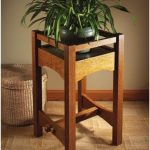We may receive a commission when you use our affiliate links. However, this does not impact our recommendations.

To start off the second day in Phil Lowe’s “Building a Demilune Table” class, we rub jointed 34 pieces with 15Ã?° angles on each end into chevrons (shown above). I thought I knew how to smear on glue and rub two pieces of wood together, but Phil showed us how to first size the end grain with a very thin layer of glue rubbed in to fill in the xylem and phloem. That, Phil says, keeps the glue used in the rub joint from being sucked up into the end grain and makes the resulting joint stronger.

After our 17 chevrons were made, we screwed and glued six of them around the edge of the pattern we routed yesterday (being careful to keep screws out of the leg-joint areas). Then, we cut close to the pattern edge on the band saw, and touched up any wonky spots with a spokeshave. Let’s just say I got some spokeshave practice. The final step for each layer was to pattern shape it on the router table. The rim was built up with three more bricked layers of chevrons and half pieces, sawing (spokeshaving) and routing each layer as we went.
The most exciting moment of the day for me (and no doubt for many of the class members), was unscrewing the rim from the pattern and seeing the shape emerge. That poplar sure is pretty , but I suspect I’ll like the bird’s-eye maple veneer even more. We scribed lines back from the front edge, and some people have already cut away the waste from the back. I was at the end of the line at the band saw and there’s no power-tool use after 6 p.m. at the Marc Adams School of Woodworking (more on that tomorrow). So my first task on Wednesday (after plugging in the glue pot for delightful olfactory ambiance), will be to remove that waste. Then it’s on to planing the tapers on the legs.
Read Part 1 of this series here.

Here are some supplies and tools we find essential in our everyday work around the shop. We may receive a commission from sales referred by our links; however, we have carefully selected these products for their usefulness and quality.










Tom,
Each piece is 15/16"-thick poplar, 1-3/4" wide, 9-1/4" long at the long side; the angle on each end is 75° (aka 15° off 90°), and thus 8-3/8" long at the shorter side.
How long are each of those pieces? I’ve created a table like that before but with 5" long pieces.
I like the ease of the longer pieces; that’s why I asked.
Thanks,
Tom
I’d use hide glue if I could get past the smell, which is the noisome equivalent of socks worn for 3 consecutive days by a long distance runner during August in Las Vegas, mixed with week-old kitty litter.
Megan, you are going to have a great time and learn a lot from Phil. Say hello for me, I wish I could be there.
I took a couple of his courses at his shop several years ago, and asked him about the always cooking glue pot. He told me the only glue failure he ever had was when using fresh glue! So, I imagine that is the reason he wants it cooking long before it is needed.
John